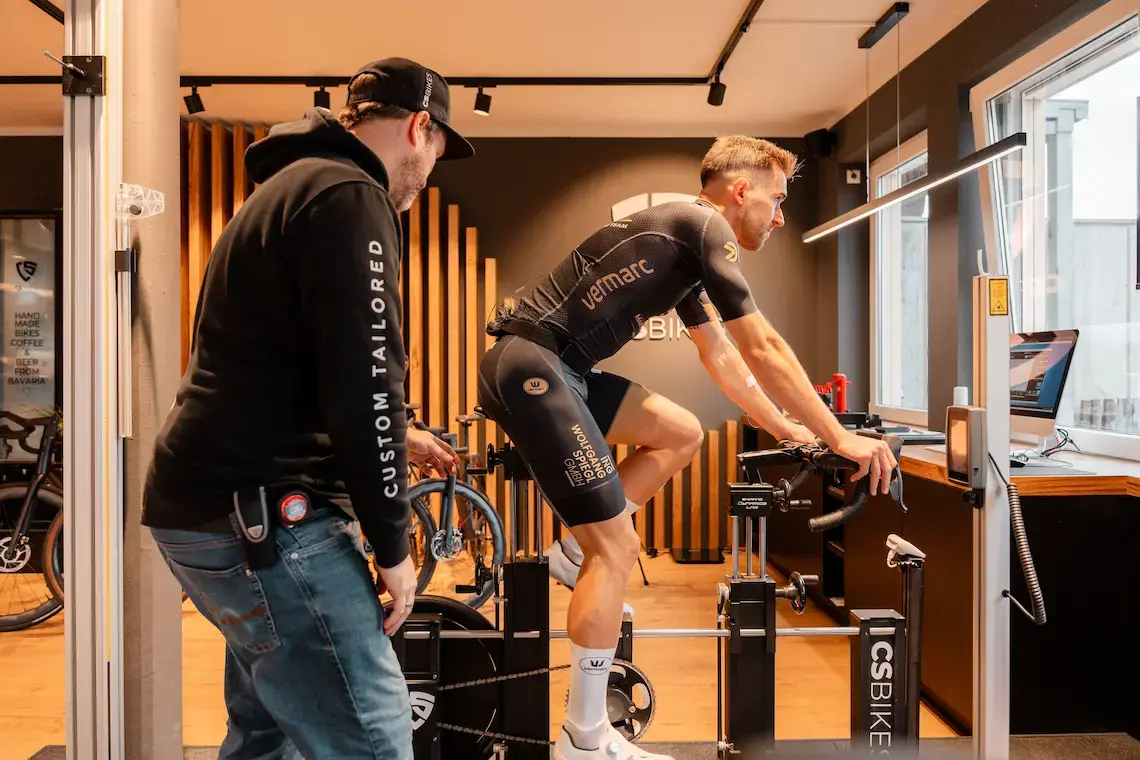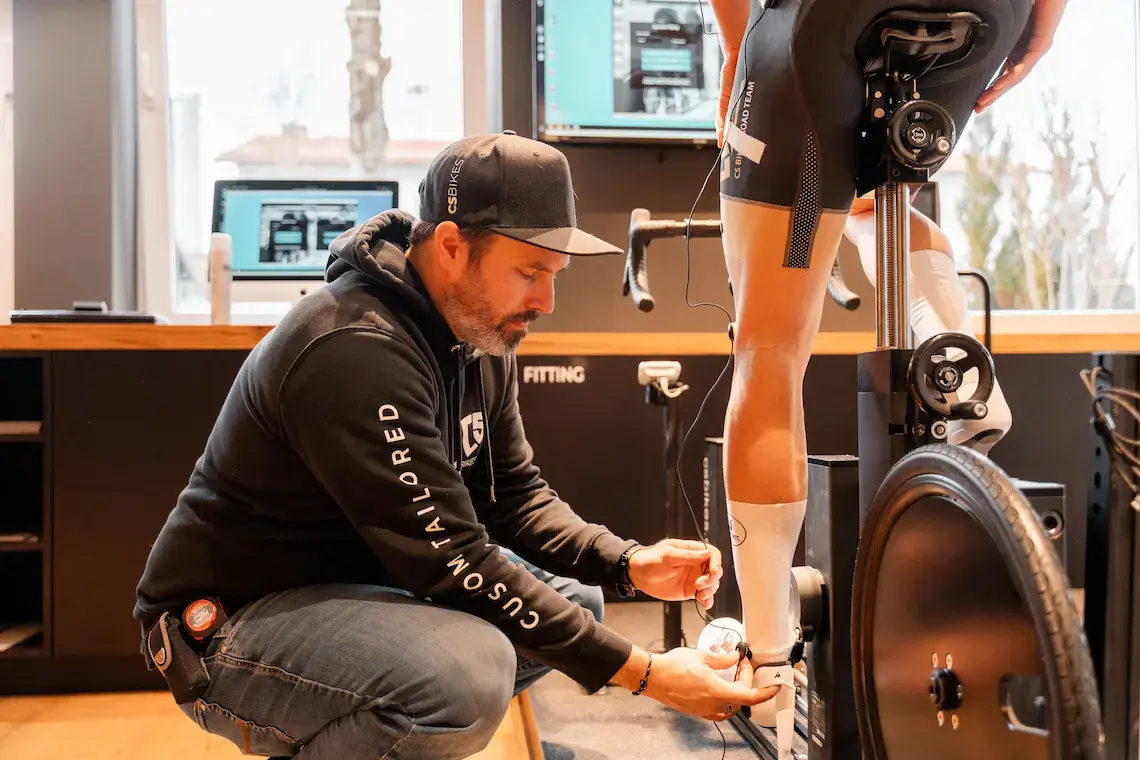Effektive Kraft und ihre Bedeutung im Radsport
|| 5 Minuten || 1208
In der komplexen Interaktion zwischen Radfahrer und Fahrrad sticht die Effizienz des Pedaltritts als entscheidender Faktor hervor. Es geht nicht nur darum, die Pedale nach unten zu drücken, sondern darum, eine effektive Kraft zu erzeugen, die das Fahrrad so effizient wie möglich vorantreibt. In diesem Artikel möchten wir genauer erklären, warum das so wichtig ist und wie wir bei CS Bikes daran arbeiten, deine Pedaleffizienz zu optimieren!
Was bedeutet "effektive Kraft" im Radsport?
Effektive Kraft im Radsport bezieht sich auf den Anteil der vom Radfahrer auf die Pedale ausgeübten Kraft, der direkt zum Vorantreiben des Fahrrads beiträgt. Sie ist die treibende Kraft hinter Geschwindigkeit und Beschleunigung und somit ein kritischer Aspekt der Leistung für Radfahrer aller Leistungsniveaus, von Freizeitsportlern bis hin zu Profis. Die Effektivität bei der Krafteinwirkung bestimmt nicht nur die Geschwindigkeit, sondern beeinflusst auch die Ausdauer und die Ermüdung.
Im Mittelpunkt jedes Pedaltritts steht ein komplexes Zusammenspiel von Biomechanik, Physiologie und Technik, mit dem Ziel, die Leistung zu maximieren und gleichzeitig den Energieverbrauch zu minimieren. Die effektive Kraft kann durch die Optimierung der Passform des Fahrers zu seinem Equipment erheblich gesteigert werden.
Biomechanik: Die Biomechanik des Radfahrens umfasst die Interaktion zwischen dem Körper des Radfahrers und dem Fahrrad, insbesondere in Bezug auf die Kraftübertragung durch das muskuloskelettale System auf die Pedale. Eine korrekte Biomechanik gewährleistet eine effiziente Kraftübertragung, verringert das Verletzungsrisiko und maximiert die Leistung.
Ausrichtung und Haltung: Die richtige Ausrichtung des Körpers, insbesondere von Wirbelsäule, Hüften und Knien, ist entscheidend für die Optimierung der Kraftübertragung.
Gelenkwinkel: Optimale Gelenkwinkel, wie Hüft-, Knie- und Sprunggelenksflexion sowie Rücken-, Schulter- und Armpositionierung, werden durch die drei Kontaktpunkte Sattel, Pedale und Lenker beeinflusst. Durch die Anpassung dieser Kontaktpunkte lassen sich die Gelenkwinkel optimieren und die Pedaleffizienz erhöhen.
Fußpositionierung: Die Position des Fußes auf dem Pedal beeinflusst die Kraftverteilung und Stabilität während des Pedaltritts. Eine korrekte Fußposition minimiert das Risiko von Fußbeschwerden und verbessert die Kraftübertragung.
Muskelphysiologie Die Erzeugung effektiver Kraft im Radsport hängt von der koordinierten Kontraktion verschiedener Muskelgruppen ab, insbesondere der unteren Extremitäten. Die physiologischen Aspekte der Muskelaktivität und Ermüdung beginnen mit der Bedeutung der Trittfrequenz, die ein entscheidender Faktor für die Optimierung der effektiven Kraft und der Leistung eines Fahrers ist. Wichtige Aspekte sind:
Muskelrekrutierungsmuster: Effiziente Rekrutierung von Muskelfasern, einschließlich schnell- und langsamzuckender Fasern.
Muskelzusammensetzung: Die Zusammensetzung der Muskelfasern einzelner Radfahrer kann ihre Fähigkeit beeinflussen, Kraft zu erzeugen und Ermüdung zu widerstehen.
Energiesysteme: Verschiedene Energiesysteme, wie aerobe und anaerobe Stoffwechselwege, werden genutzt, um die Kraftentfaltung bei unterschiedlichen Intensitäten aufrechtzuerhalten.
Neuromuskuläre Koordination
Die Koordination von Muskelaktivierungsmustern und motorischer Kontrolle ist entscheidend. Die Trittfrequenz spielt eine wesentliche Rolle und beeinflusst direkt die Koordination der Muskelaktivierungsmuster, was zu einem reibungslosen und effizienten Pedaltritt führt.
Motorische Einheiten: Motorische Einheiten innerhalb der Muskeln bestehen aus einem Motoneuron und den von ihm aktivierten Muskelfasern. Die Rekrutierung motorischer Einheiten bestimmt die Kraftentwicklung und die Geschwindigkeit der Kraftentwicklung während des Pedaltritts.
Kraftvariabilität: Minimierung von Schwankungen der Kraftentwicklung während des Pedaltritts ist essenziell für eine gleichmäßige und konsistente Radfahrmechanik.

Der Unterschied zwischen effektiver und weniger effektiver Kraft
Forschungen wie „Differences in pedaling technique between road cyclists of different competitive levels“ von Juan García-López et al. (2014) untersuchen die Unterschiede in der Pedaltechnik zwischen Radfahrern unterschiedlicher Leistungsklassen. Diese Studie hebt hervor, dass Profiradfahrer aufgrund geringerer Widerstandsmomente während der Aufwärtsbewegung und höherer Gelenkflexibilität sowie Muskelansteuerung eine höhere Effizienz aufweisen.
Die Unterschiede in der effektiven Kraft zwischen Profis und Freizeitradfahrern zeigen sich auf verschiedene Weise:
Geschwindigkeit und Leistung: Profiradfahrer erreichen aufgrund höherer Spitzenleistung und effizienterer Pedaltritte höhere Geschwindigkeiten und bessere Gesamtleistungen.
Ausdauer und Effizienz: Profiradfahrer können über längere Zeiträume höhere Leistungen erbringen, da sie besser konditioniert sind und eine optimierte Biomechanik aufweisen. Ihre Pedaltritte sind effizienter und minimieren Energieverluste sowie Ermüdung.
Technik und Form: Profiradfahrer zeigen in der Regel gleichmäßigere und konsistentere Pedaltritte mit optimierter Krafteinwirkung während des gesamten Tritts.
Equipment-Nutzung: Profis nutzen modernstes Fahrradequipment, das auf ihre biomechanischen Bedürfnisse abgestimmt ist, was die Kraftübertragung und Effizienz verbessert.

Was bedeutet das für dich?
Effiziente Kraftentfaltung ist nicht nur für Profis relevant, sondern ebenso wichtig für die Verbesserung der Leistung und des Fahrvergnügens von Freizeitradfahrern. Faktoren wie die richtige Fahrradanpassung, geeignetes Equipment und eine individuelle Trittfrequenz spielen eine entscheidende Rolle bei der Optimierung der Pedaleffizienz und tragen maßgeblich zu einer besseren Gesamtleistung und mehr Komfort für Radfahrer aller Leistungsniveaus bei.
Wichtiger Hinweis: Unterschätze niemals die Bedeutung der Pedaleffizienz – sie macht dich schneller und reduziert gleichzeitig die Ermüdung!
Nicholas Schick, ein in Deutschland lebender Amerikaner, ist der Gründer von CSBikes und dient seit 2020 als Geschäftsführer. Mit 15 Jahren Erfahrung im Bike-Fitting hat er die Konzepte entwickelt, die heute alle Abläufe bei CSBikes prägen. Sein Ansatz umfasst einen umfassenden vorbereitenden Fitting-Prozess, der dynamische 3D-Bewegungssysteme, Pedalanalyse und Druckmessung nutzt. Er ist von Shimano-Labs BikeFitting, SQ-Labs und ID-Match zertifiziert.

